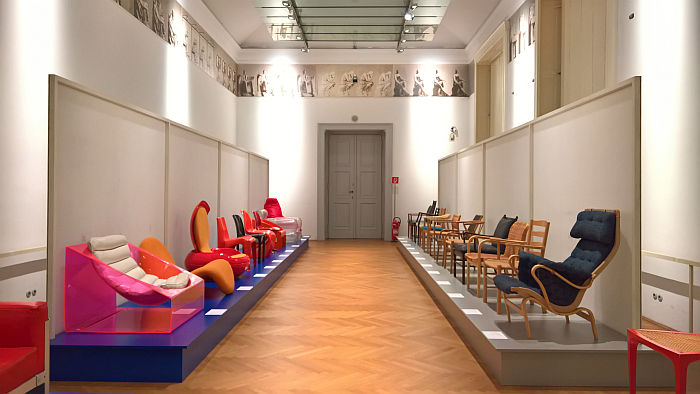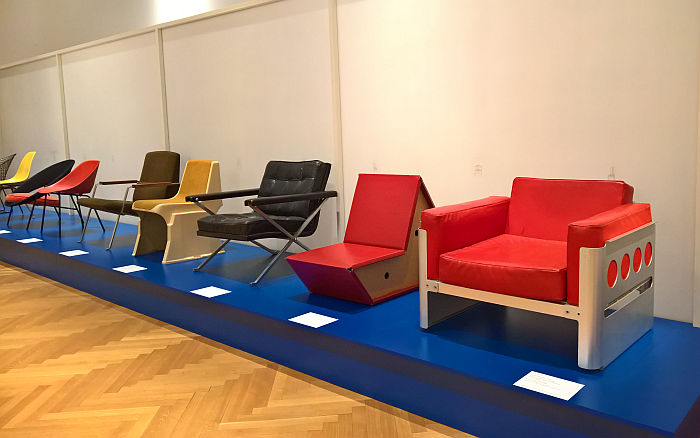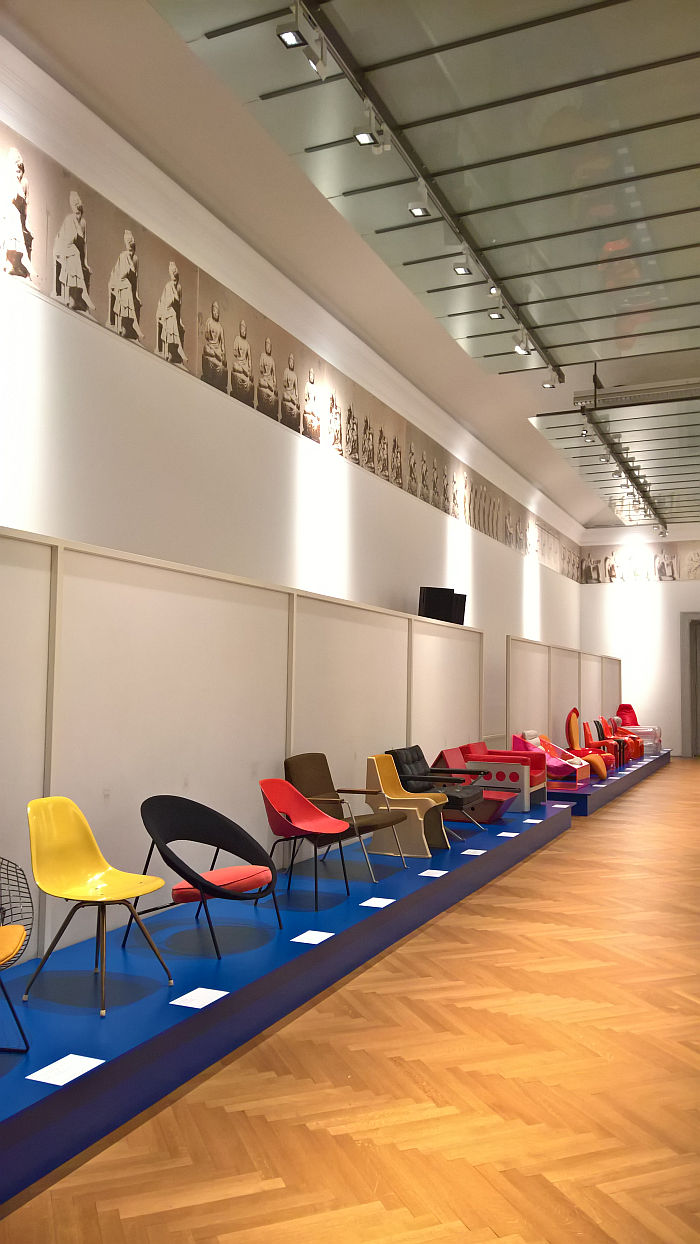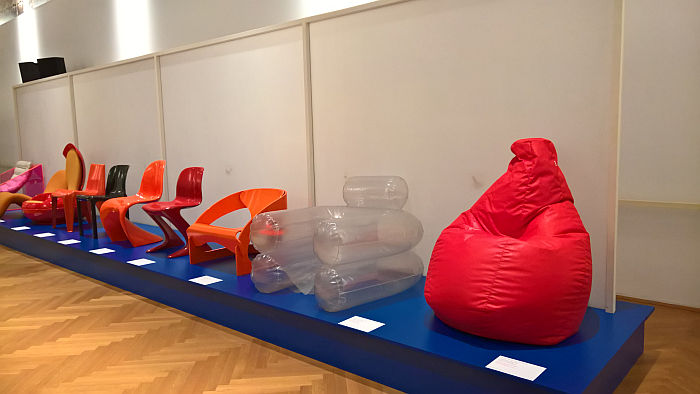Sitzen 69 Revisited @ MAK – Museum für angewandte Kunst, Vienna
“Since the founding of the museum in 1864 there has been an ongoing committent to honouring the statute of the house, namely, to promote the art industries and the arts and crafts and to develop the taste of contemporary society”1
So noted the, then, Österreichisches Museum für angewandte Kunst’s Director Wilhelm Mrazek in the catalogue to the museum’s 1969 exhibition Sitzen 69, Sitting 69, an exhibition which sought “to develop the taste of contemporary society” in terms of sitting/seating.
And that through a presentation of (largely) wooden chairs, several of which dated back to the 1930s and 1940s………
…….in 1969.
?????????
With the showcase Sitzen 69 Revisited the, now, MAK – Museum für angewandte Kunst initiate a debate on the apparent contradictions inherent in Sitzen 69, and on the wider question of the mediation of design, through a presentation of objects presented in 1969 juxtaposed with some of those chair designs that weren’t. Chair designs that one may have, reasonably, expected should, would, have been……
1969 was famously after 1968 and therefore not just a moment of social, cultural and political upheaval every bit as interesting and enduring as that which occurred in 1989, but also an interesting and enduring moment in furniture design: not just through the rapid rise in the use of new materials, for all plastics, but also through an increasing radicalisation amongst architects and furniture designers, and an increasing questioning of the established norms and conventions of furniture, for all the form/function relationship and the relationship between object, space and user.
And therefore not necessarily a year in which many would consider focussing on wooden chairs as best case examples of good contemporary furniture design. Nor necessarily Scandinavian wooden chairs; lest we forget, the famous Copenhagen Cabinetmakers’ Guild exhibition, that annual showcase which did so much to establish the post-War Danish furniture tradition, and the reputations of protagonists such as Børge Mogensen, Hans J Wegner or Finn Juhl, was staged for the final time in 1966. The same year Star Trek started. Even in Scandinavia design was evolving, exploring the final frontier, boldly going where no man had gone before, had, if one so will, entered the Utopia phase of the Bröhan Musem Berlin’s exhibition Nordic Design. The Response to the Bauhaus.
Yet that is exactly what the Österreichisches Museum für angewandte Kunst did with a presentation of some 70 wooden chairs by 48 creatives from 7 countries, primarily, in addition to local Austrians, designers and architects from Scandinavia.
Why?
Indeed.
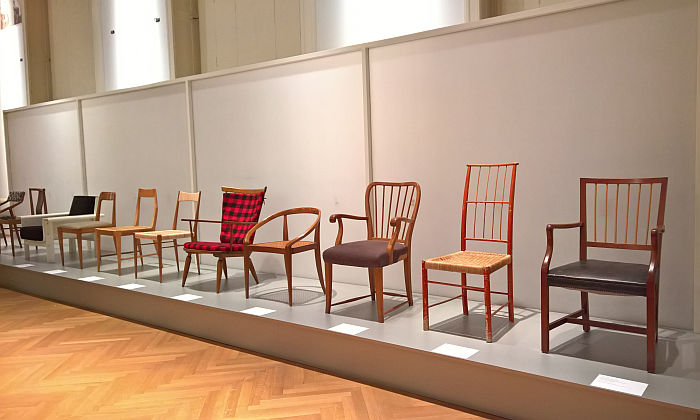
A collection of wooden chairs originally presented as part of Sitzen 69, as seen at Sitzen 69 Revisited @ MAK – Museum für angewandte Kunst, Vienna
The start of an approach to an answer lies in the above quote from Wilhelm Mrazek, specifically the phrase “to promote the art industries and the arts and crafts”. The exhibtion was, as we learn from the catalogue, angeregt – suggested/initiated/motivated – by Vienna City Councillor Dr Pius Prutscher, a Master Carpenter and former head of the Viennese Carpenters’ Guild, and realised with the help and cooperation of said Carpenters’ Guild.
And which implies an attempt to support the local Viennese carpentry industry as much as to educate public taste. An implication confirmed for Sitzen 69 Revisited curator Dr Sebastian Hackenschmidt, a man who has been kept busier by such thoughts for much longer than we have, by the prominence given in the original exhibition to Josef Frank: today Josef Frank may be best known for his textiles and his post-War work in Sweden, for all his cooperations with Stockholm’s Svenskt Tenn; however, in the inter-War years Frank was a leading protagonist in Vienna, and the 1969 catalogue notes, with, one senses, a great deal of pride, that in 1935 the Hoffman Verlag in Stuttgart published a book titled Wiener Möbel [Viennese Furniture] a work which, as Sitzen 69 curator Franz Windisch-Graetz is keen to highlight, featured work by Josef Frank, and that, “we have endeavoured to include at least a few examples of his work”. Six. Six Josef Frank chairs were presented in the original 1969 exhibition, a little under 10% of the total, more than from any other designer, and all of which dated from the early 1930s and all had featured, if sometimes in different variations, in Wiener Möbel.
And why Josef Frank?
For all when one considers that in Wiener Möbel from the 8 “Josef Frank” chairs, 7 are listed as anonymous works by Frank & Oskar Wlach’s Haus und Garten brand, and only one alone mentions as designers “Frank & Wlach”. A pairing that also crops up in the Haus und Garten desks, tables, beds etc, etc, etc. Josef Frank is never listed as sole creator of a work. While in Sitzen 69 Oskar Wlach isn’t credited with any of the designs. Highlighting Josef Frank in Sitzen 69 being to slightly overstate his presence in Wiener Möbel.
And so, why Josef Frank?
“Because one can with very good reason refer to him as the founder of the then “new Viennese style””, replies the echo of Franz Windisch-Graetz from 1969.
And because he is important in a Scandinavian context, replies, perhaps slightly overly cynically, our echo from 2019.
Or put another way.
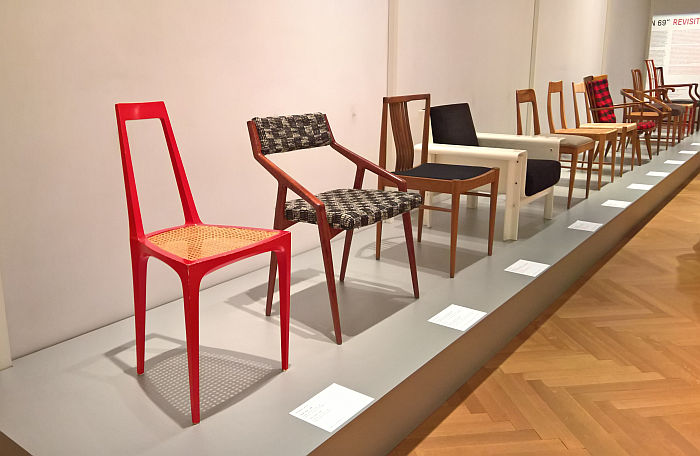
Austrian chairs originally presented at Sitzen 69, as seen at Sitzen 69 Revisited @ MAK – Museum für angewandte Kunst, Vienna
One can understand a focus on a designer such as Josef Frank as an attempt to couple on to the work, the Vienna, of the early 1930s, an era when Vienna was an important centre for furniture design, something it had been since the days of the Habsburg Empire, which achieved a new relevance and impetus through Michael Thonet’s 19th century bentwood furniture, and which continued over the various epochs of the late 19th/early 20th centuries. And something which by 1969 it wasn’t. By 1969 Europe’s major furniture centres were to be found much more in Italy or Scandinavia: the former for all through its Radicals and their plastics, the sort of protagonists who in 1972 the MoMA New York celebrated in the exhibition Italy: The New Domestic Landscape. The latter, and despite the evolutions afoot, by the continuing, if fading, resonance of its wood and carpenters.
Sitzen 69 featured two chairs from Italy, one by Gio Ponti and one by Giancarlo Piretti, whereby one notes not Piretti’s 1969 Plia plastic folding chair, but his 1965 metal & plywood DSC 106. And some 24 from Denmark, Sweden, Norway and Finland, including works by the likes of Kaare Klint, Bruno Mathsson, Alvar Aalto or Verner Panton, the latter not by his plastic cantilever chair for Vitra, but by his moulded beech plywood 270 F for Thonet.
The direction the Österreichisches Museum für angewandte Kunst were hoping to move the discussion was unequivocal.
And a direction, they, and also, one imagines, the Viennese Carpenters’ Guild, were, arguably, keen to demonstrate was not only probable and realistic in late 1960s Vienna, but was inherent in the Viennese furniture tradition.
Thus alongside Josef Frank’s works Sitzen 69 featured Austrian works by likes of Otto Niedermoser, Ernst Anton Plischke or Oswald Haerdtl, who had all studied in the early 20th century at Vienna’s Kuntsgewerbeschule under the likes of Josef Hoffmann or Oskar Strnad, both of whom featured prominently in Wiener Möbel, but both a tick older than Josef Frank, and thereby linking the presentation in to the early 20th century Viennese tradition; and also featured works by contemporary students at Vienna’s Akademie für Angewandte Kunst, including works that could have effortlessly featured in any 1960s Scandinavian manufacturer’s portfolio, we’re thinking particularly of Winfried Vozicky’s filigree, bone-esque, armchair or Erwin Kube’s stacking childrens’ chairs. While in Dominic Habsburg-Lothringen’s 1960 design for Copenhagen based Jørgen Wolff Møbelsnedkeri, Sitzen 69 featured a work by an Austrian for a Scandinavian manufacturer. And a nice reminder of the role of the Austrian monarchy and nobility in the development of Austrian furniture traditions.
And thus works which in many regards can be understood as continuing, visualising, the argument Franz Windisch-Graetz formulates in the catalogue that with his 1934 emigration to Stockholm Josef Frank carried the spirit and essence of contemporary Viennese design understandings, the “new Viennese style”, to Sweden and thereby influenced post-War Scandinavian design; and thus, how, now, in 1969, Vienna could rediscover the vigour of its 1930s albeit informed through a post-War Scandinavian carpentry tradition itself informed by the “new Viennese style”, if one so will a “ny wienerstil”. A circle completed. And a new, new Viennese style to compete with the brash, audacious plastics.
And thus one can very much understand Sitzen 69 as about reinvigorating a (potentially) sluggish Viennese furniture industry. For all the wooden chair sector and the workshops of the Viennese Carpenters’ Guild.
And if so, does that in any way disrepute Sitzen 69 as an exhibition?
Far from it. Invigorating local industry is what regional and national institutions do. Is why they’re tax funded. Or at least should be tax funded.
OK, but if Sitzen 69 was about invigorating a no longer existent, or when then fundamentally and structurally different, late 1960s Viennese furniture industry, why do we need to revisit it?
Because revisiting it not only allows for reflections on the contemporary mediation of design, but very succinctly reminds us that design, as with life, is something that can only be understood backwards.
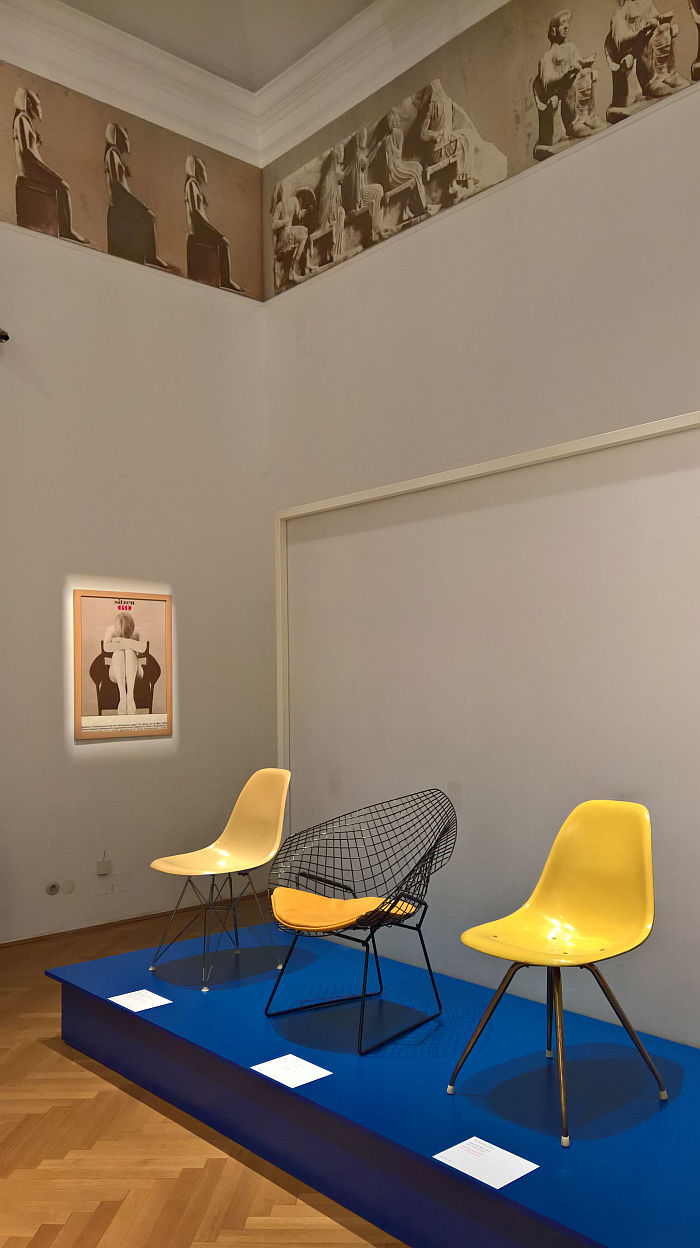
The original Sitzen 69 exhibition poster looks over chairs that weren’t included, , as seen at Sitzen 69 Revisited @ MAK – Museum für angewandte Kunst, Vienna
In context of the Vitra Design Museum Schaudepot’s exhibition After the Wall. Design since 1989 we opined that while one can speak today of a move towards a Post-Plastic society, of Post-Plastic design, the 1960s were in many regards about plastics enabling a move towards a Post-Wood society, Post-Wood design. Something particularly satisfyingly presented in Sitzen 69 Revisited through its presentation format: on one side of the space two dozen-ish wooden chairs, on the other side two dozen-ish (more or less exclusively) plastic chairs.
A presentation format which not only allows for a very clear demonstration of how plastics allowed for the creation of new formal vocabularies and new relationships within furniture design, allowed designers to develop practical objects and express theoretical positions that would be all but impossible in wood, and thus very neatly underscores the genuine revolution plastics brought to furniture design, and by extrapolation the importance of new materials in helping design and architecture evolve and develop. And yes also posing, again, the question of in how far our current troubled relationship with plastics is the fault of plastics or the fault of egoistic human society?
And which similarly allows for reflections on wider ideas of sustainability in furniture design. Not just sustainability in terms of resources, durability, longevity and disposal, but also a sustainability in terms of formal aesthetics: for us the wooden chairs are, and perhaps generalising more than is helpful, but for us the wooden chairs are as a group more engaging and approachable than their plastic opposite numbers. Which isn’t to say there aren’t a few gems amongst the plastic chairs, there are; however, is to say that, for us, as a group the wooden chairs are/were more engaging and approachable, while many of the plastic works still resemble improbable, fanciful, experimentations, entertaining to look at, but not chairs for life. A state of affairs that, arguably, can be traced to an inherent human affinity to wood as a material which makes us question wooden objects less, accept them more readily. And/or which reflects the fact that the (relatively) limited options for wooden chair forms means any given wooden chair is more instantly recognisable and comprehensible, than a more freely formed plastic chair.
And a state of affairs which reminds of an earlier, failed, attempt to create a Post-Wood society: inter-War tubular steel, and as deliciously exemplified by Charolotte Perriand’s 1929 essay Wood or Metal? in which she sides fully with the later, the former being denounced as a “… vegetable substance, bound in its very nature to decay….”2 Yet as we’ve oft noted, for all the association of inter-War Europe with tubular steel chairs, most people were using wooden ones. And since the war…….?
And so on account of their durability, longevity, sustainability, and popularity, was the Österreichisches Museum für angewandte Kunst not correct in 1969 to pitch wooden chairs over plastic?
Arguably yes, arguably wooden chairs will, so history teaches us, always have a place and role in our society and one can, validly, talk, for all in context of our current environmental considerations, of wooden chairs as contemporary and future orientated. Sitzen 69‘s motivations may have been more commercial, but as Sitzen 69 Revisited elegantly highlights, the resultant display was socially and culturally responsible.
But also no, whereby we lean more to the no; primarily because, for us, museums should be places which not only store, collate and exhibit the past, but where people can inform themselves on new developments and possible future directions, in which context discussion and discourse are always more important in helping meaningful, sustainable, opinions form than being told what to think. Or put another way, we’d disagree with Wilhelm Mrazek’s claim that museums’ should “develop the taste of contemporary society”, rather for us museums should, must, be neutral environments which allow individuals a space in which to develop by themselves their own understandings and positions, not guide them in specific directions. And to do that must present the contemporary and experimental alongside the established.
And that both then, in 1969, and now in 2019, an age in which understandings of design, of what is good, probable, sensible, meaningful design, are increasingly informed by the homogeny, anonymity and improbability of social media, with all its shortcuts, half-truths, distortions, post-produced images, and for all its algorithms which tend to promote those who shout loudest rather than those who have the most interesting, reasoned, arguments. An age where “new” is considered a synonym for improved, desirable, inevitable. And in an age such as ours we need spaces where we have the freedom, independence and time to openly and honestly reflect and consider.
Sitzen 69 approached just such a space. Sitzen 69 Revisited reaches just such a space. A space to look back. And forward.
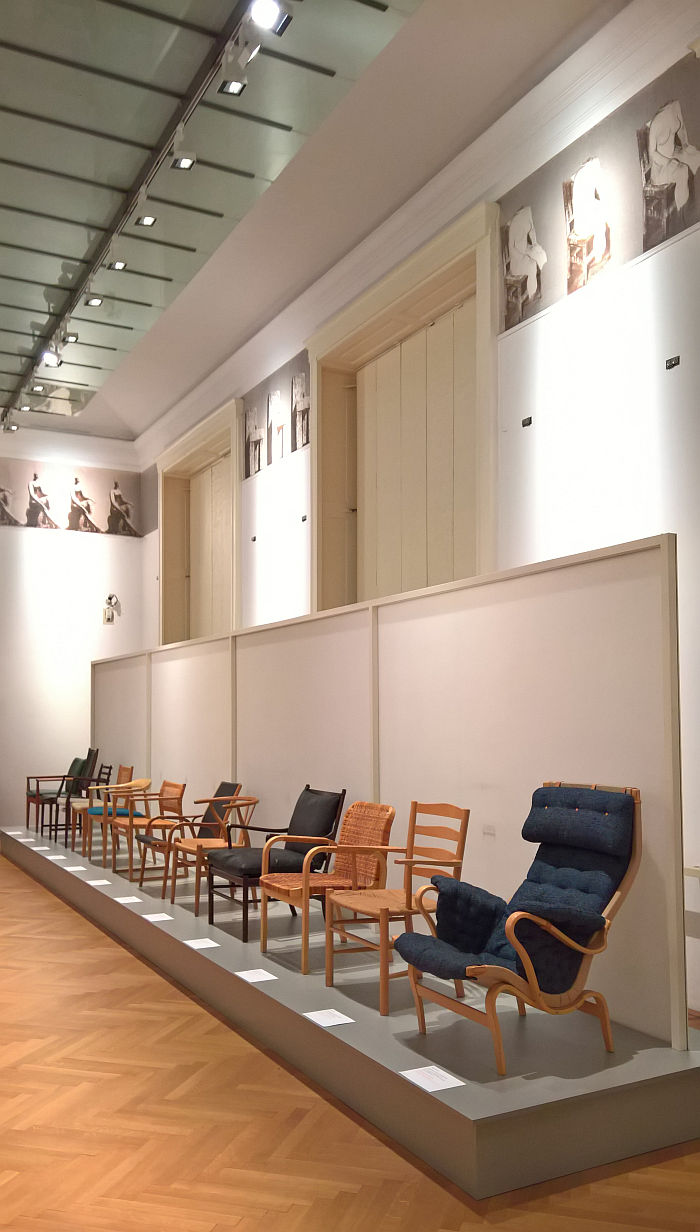
Wooden chairs from Scandinavia which formed part of Sitzen 69, as seen at Sitzen 69 Revisited @ MAK – Museum für angewandte Kunst, Vienna
Whereas we, admittedly, would have (much) preferred a presentation which juxtaposed the complete Sitzen 69 presentation with works that one may have, reasonably, expected should, would, have been presented, but which weren’t, not least because of the sheer number of works in the catalogue which today are rarely, if ever, seen en persona; the reduction down to some two dozen, mirrored by two dozen (more or less) plastic alternatives, does however allow for much more concise and thus more focussed considerations on the validity of the original showcase, the contrasting claims of wood and synthetics in furniture design, our functional, emotional and intellectual demands on furniture, the relationship between object, space and user, etc, etc, etc, and in doing so also allows for some rarely seen perspectives of 20th century furniture design, and for all a better understanding of just how incomplete our understanding of the (hi)story of furniture design is.
One the one hand, our incomplete understanding of the (hi)story of furniture design through a popular focus on a relatively small number of designers. Something neatly illuminated by Frank & Wlach. Frank & who? Similarly, whereas the likes of a Finn Juhl, a Gio Ponti or a Verner Panton will be known to many, the likes of a Wilhelm Amberger, a Studio Rossi-Molinari, or a Norbert Schlesinger aren’t. And while admittedly there may well be (good) reasons therefore, the reality that the (hi)story of furniture design is a (hi)story of inter-relationships, cross pollinations and gradual progressions and evolutions, means the more protagonists one knows, the denser the line of dots one joins, the better the understanding, the clearer the image that emerges. In addition one notes that from the 48 designers featured in Sitzen 69 two were female, Anna Praun and Heidemarie Leitner, a female:male ratio of 1:24. Both Anna Praun and Heidemarie Leitner are also featured in Sitzen 69 Revisited, joined on the other side of the room by Geneviève Dangles with her 1958 Saturne armchair for Burov, thereby enabling a Sitzen 69 Revisited female:male ratio of 1:15* Which is arguably better than any given 1969 exhibition would have realistically achieved. And which reminds, once again, of our skewed, male-centric, understandings of design history. Whereby one must also add that Sitzen 69 Revisited does include a DSR for Herman Miller by ……… Charles Eames.
???
Or, as an undated conversation between Charles Eames and the astronomer Owen Gingerich unfolded,3
Owen Gingerich: “…you looked around and said “These are all my chairs””
Charles Eames: “I probably said, “These are all our chairs””
Owen Gingerich: “Never mind.”
Charles Eames: “But it’s unlike me to say “my chairs””
And on the other hand, our incomplete understanding of the (hi)story of furniture design through a popular focus on a relatively small number of objects. While many of the works on show in Sitzen 69 Revisited are well known and oft shown works, such as the Eames’ DSR, or Sacco by Gatti, Paolini & Teodoro, Peter Ghyczy’s Gardenegg or Hans J Wegner’s CH 24 a.k.a. Wishbone; many others aren’t, for all amongst the Sitzen 69 wooden chairs, a presentation that includes works such as Johannes Spalt’s 1963 armchair for Franz Wittmann, Børge Mogensen’s chair 62 for P Lauritsen & Son, or Norbert Schlesinger’s distracting yet charming armchair for the Austrian Pavilion at the 1958 World’s Expo in Brussels.
And thus as a presentation Sitzen 69 Revisited underscores how much there is to be discovered in terms of furniture design, and why one should never stop looking.
For all looking backwards, if always with one eye firmly on the future……
Sitzen 69 Revisited runs at the MAK – Museum für angewandte Kunst, Stubenring 5, 1010 Vienna until Sunday March 29th.
Full details can be found at https://mak.at/sitzen69revisited
1. sitzen 69 Moderne Tischlersessel und ihre Werkzeichnungen, Österreichischen Museum für angewandte Kunst, 1969
2. Charlotte Perriand, Wood or Metal? The Studio, Vol 97, No. 433, 1929
3. Owen Gingerich, A Conversation with Charles Eames, The American Scholar Vol. 46, No. 3 (Summer 1977), Washington, D.C
* Provisionally, the identity, and number, of the designers behind Toy by Studio Rossi-Molinari is neither confirmed nor equivocal
Tagged with: Josef Frank, MAK, Museum für angewandte Kunst, Sitzen 69, Sitzen 69 Revisited, Vienna, Wien
